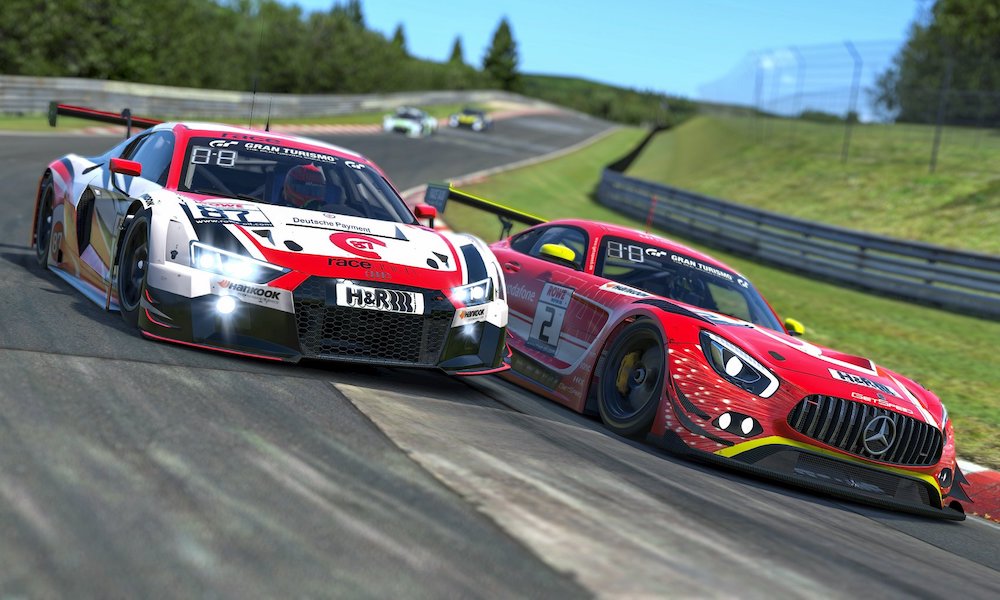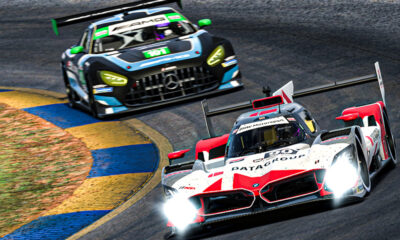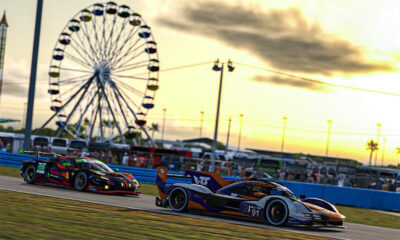
Photo: Gary Parravani/Xynamic
The current racing downtime is particularly challenging for the many motorsports professionals who are paid on a ‘race-by-race’ basis, but those in some areas of the industry have found ways to keep business ticking over while working from home.
One of the most interesting revelations in recent weeks has been the emergence of high-quality esports photography, which has allowed some of the sport’s most versatile photographers to capture virtual racing in stunning definition.
Shooting for clients like SRO Motorsports Group and Bentley, Gary Parravani has already been responsible for a number of impressive virtual photoshoots including a mock Total 24 Hours of Spa parade that descended into chaos, but only after Parravani was able to ‘hover’ and ‘fly’ around the track to take shots that he wouldn’t even be able to produce in real life.
“When we left the SRO Paul Ricard test [in March] there was a very strange atmosphere,” Parravani tells Sportscar365.
“We all had the feeling we wouldn’t see each other or be back at a circuit for quite a while.
“It was obvious that motorsport photography would bring no income for possibly the rest of the year. I made a list of other ways to earn some money.
“First on the list was to do non-motorsport photography at home. At the bottom of the long list was to do esports motorsport photography.
“After a few days the UK went on lockdown and I had to cross everything off my list apart from esports photography.
“I used my overdraft to buy a gaming PC, plugged in an old monitor and downloaded Assetto Corsa Competitzione.
“Next thing I knew, I was ’shooting’ for automotive manufacturers, teams, drivers and gaming hardware manufacturers.”
Sam Cobb normally shoots series including the IMSA WeatherTech SportsCar Championship, NTT IndyCar Series and NASCAR, but his introduction to esports photography has been in the works for a while.
His esports clients include BMW, the IMSA iRacing Pro Series and the Virtual Competition Organisation (VCO), which organizes the Digital Nürburgring Endurance Series races.

Photo: Sam Cobb/VCO
“It started a long time ago,”Cobb says. “I have been playing video games myself for a long time, and there was always one part of the game that you wanted to show your friends, so you took a screenshot of it.
“When BMW started to get more involved in esports racing last year, I began to deal with it more professionally.”
Compared to real-life photography, stepping into the virtual world allows experts like Cobb and Parravani to control and dictate weather conditions and car positions like never before, while also reaching new angles that would otherwise be completely impossible.
“I love to get as close to the car as possible when I am taking photos, because it gives the image a totally new dimension,” says Cobb.
“In the virtual world, you can stand on the other side of the crash barrier to take a photo. And, unlike in real motorsport, you can also switch quickly between locations.”
“Originally I thought the main advantage of being a real-world motorsports photographer would be that I know where the real-life spots are to take the photos,” Parravani adds.
“I could fly around Monza and land in exactly the same place I would shoot from in real life. I’d then try and get exactly the same shot with same setting so I could compare.
“This quickly became boring and it was more fun to do all the things you cant do in real life like tracking a car from 1 cm above the track during a race, or even riding with the driver.
“If you aren’t shooting a race specifically you can do incredible things that you cant do in a real-life photoshoot.
“For example, I shot some images for a team where I wanted the sun in a certain place at Zandvoort. So I purchased the track in iRacing, looked on the weather app that I use in real life and found the exact date and time of the year that the sun would be in the right place.
“I entered all that data into iRacing et voila! Now I have the car in the right spot with the right weather and the right lighting.”
With the return to real racing edging closer and closer as lockdown restrictions are lifted, neither photographer knows how long the esports boom will continue, but both are fully behind the phenomenon for now.
“I think it is fantastic how popular this topic is now, and how awareness of it is growing all the time,” says Cobb.
Parravani sees esports as a way for his agency Xynamic to expand in the long-term, alongside ‘traditional’ real-life shoots.
“I’m going to be very interested to see what happens with esports after this and specifically whether manufacturers continue with it when real-world racing starts again,” he says.
“If they do then I’m going to stick with it, for sure. I was already looking for a way to diversify and expand the agency, and this has been a lot of fun.”

Photo: Sam Cobb/VCO


























